What'sNEW Apr - Jun 2019
Novacene: The Coming Age of Hyperintelligence is James Lovelock's newest book, available next week, just before he turns 100 years old. Novacene is his name for the coming era when intelligent robots take over the planet and facilitate its rescue. After all he has done, James is entitled to speculate freely. "He now sees himself as an engineer who values intuition above reason," says reviewer Tim Radford. We welcome Radford's synopsis of Lovelock's life and earlier work, especially Gaia theory. Gaia awakened and stimulated Earth system science and is now entirely respectable. We are glad that Lovelock and Gaia have flourished. We plan to read the book. (Can robots have intuition?)
 James Lovelock at 100: the Gaia saga continues: book review by Tim Radford, Nature, 25 Jun 2019. James Lovelock at 100: the Gaia saga continues: book review by Tim Radford, Nature, 25 Jun 2019.
 Cyborgs will save humanity, says James Lovelock: book review in The Economist, 25 Jun 2019. Cyborgs will save humanity, says James Lovelock: book review in The Economist, 25 Jun 2019.
 Gaia has background about Lovelock and updated links. Gaia has background about Lovelock and updated links.
NASA’s Curiosity rover reports the highest-ever reading of [methane] at the planet's surface.
 Mars rover detects 'excitingly huge' methane spike, Nature News, updated 25 Jun 2019. Mars rover detects 'excitingly huge' methane spike, Nature News, updated 25 Jun 2019.
 With a Poof, Mars Methane Is Gone by Dennis Overbye, The New York Times, 25 Jun 2019. With a Poof, Mars Methane Is Gone by Dennis Overbye, The New York Times, 25 Jun 2019.
 Life on Mars! has background and updates. Search for "methane". Life on Mars! has background and updates. Search for "methane".
 Thanks, Stan Franklin and Martin Langford. Thanks, Stan Franklin and Martin Langford.
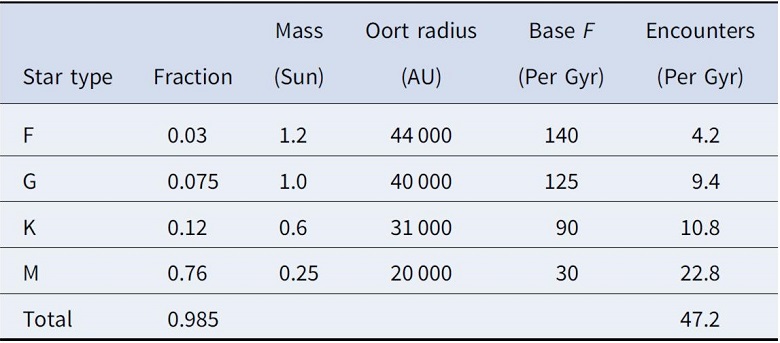 ...exchange of materials between solar systems during close stellar encounters could be an important mechanism for spreading life throughout the galaxy. This conclusion comes in a volumetric analysis of the sun's meanderings among neighboring stars, by astrobiologist Robert Zubrin. Comets and cometary dust in the Oort clouds, ours and theirs, can be swapped with surprising frequency. These encounters could explain large impacts and major evolutionary transitions on Earth, Zubrin also notes.
...exchange of materials between solar systems during close stellar encounters could be an important mechanism for spreading life throughout the galaxy. This conclusion comes in a volumetric analysis of the sun's meanderings among neighboring stars, by astrobiologist Robert Zubrin. Comets and cometary dust in the Oort clouds, ours and theirs, can be swapped with surprising frequency. These encounters could explain large impacts and major evolutionary transitions on Earth, Zubrin also notes.
 Exchange of material between solar systems by random stellar encounters [pdf] by Robert Zubrin, International Journal of Astrobiology, doi:10.1017/S1473550419000144, online 18 Jun 2019. Exchange of material between solar systems by random stellar encounters [pdf] by Robert Zubrin, International Journal of Astrobiology, doi:10.1017/S1473550419000144, online 18 Jun 2019.
 Comets: The Delivery System has background, references and updated links. Comets: The Delivery System has background, references and updated links.
The subsurface ocean of Saturn's moon Enceladus probably has ...conditions favorable to life....
 Abundance of gases in Enceladus's ocean are a potential fuel – if life is there to consume it, UW News, 19 Jun 2019. Abundance of gases in Enceladus's ocean are a potential fuel – if life is there to consume it, UW News, 19 Jun 2019.
 Saturn's Moon Enceladus Has Nutrient-Rich Oceans, futurism.com, 19 Jun 2019. Saturn's Moon Enceladus Has Nutrient-Rich Oceans, futurism.com, 19 Jun 2019.
 ...Enceladus Is Likely the 'Perfect Age' to Harbor Life by Yasemin Saplakoglu, Live Science, 02 Jul 2019. ...Enceladus Is Likely the 'Perfect Age' to Harbor Life by Yasemin Saplakoglu, Live Science, 02 Jul 2019.
 Life on Europa, Other Moons, Other Planets? has related links. Life on Europa, Other Moons, Other Planets? has related links.
 Thanks twice, Stan Franklin. Thanks twice, Stan Franklin.
| 20 Jun 2019 | What'sNEW about HGT  | | |
Viruses can communicate using tiny peptides, signalling that it's time to go dormant, for example. Wow.
 The secret social lives of viruses by Elie Dolgin, Nature, 18 Jun 2019. The secret social lives of viruses by Elie Dolgin, Nature, 18 Jun 2019.
 Thanks, Martin Langford. Thanks, Martin Langford.
 Viruses... has lots about viruses, but signalling and cooperating are news to us. Viruses... has lots about viruses, but signalling and cooperating are news to us.
Cephalopods, flies and even humans share genes needed to develop limbs....
 Cuttlefish Arms Are Not So Different From Yours by Carl Zimmer, The New York Times, 18 Jun 2019; re: Cuttlefish Arms Are Not So Different From Yours by Carl Zimmer, The New York Times, 18 Jun 2019; re:
 Evolution of limb development in cephalopod mollusks by Oscar A Tarazona et al., eLife, 18 Jun 2019. Evolution of limb development in cephalopod mollusks by Oscar A Tarazona et al., eLife, 18 Jun 2019.
This may mean that an ancient system for creating limbs emerged over 500 million years ago in the earliest animals with bilateral symmetry....
 Thanks, Stan Franklin. Thanks, Stan Franklin.
 Metazoan Genes Older Than Metazoa? has updates about genes that look inexplicably old. Metazoan Genes Older Than Metazoa? has updates about genes that look inexplicably old.
 Genes Older Than Earth? has more. Genes Older Than Earth? has more.
 Massive Mars crater could have hosted life, Mars Daily, 06 Jun 2019. Massive Mars crater could have hosted life, Mars Daily, 06 Jun 2019.
 Does the Red Planet harbour life?... by Stuart Clarke, Science Focus (BBC), 10 Jun 2019. Does the Red Planet harbour life?... by Stuart Clarke, Science Focus (BBC), 10 Jun 2019.
 Life on Mars! has more. Life on Mars! has more.
 Thanks, Rob Cooper and Ronnie McGhee. Thanks, Rob Cooper and Ronnie McGhee.
| 05 Jun 2019 | What'sNEW about HGT  | | |
Another gene for cellular metabolism has been found in giant viruses.
 On the occurrence of cytochrome P450 in viruses by David C. Lamb, Alec H. Follmer, Jared V. Goldstone et al., doi:10.1073/pnas.1901080116, PNAS, 05 Jun 2019. On the occurrence of cytochrome P450 in viruses by David C. Lamb, Alec H. Follmer, Jared V. Goldstone et al., doi:10.1073/pnas.1901080116, PNAS, 05 Jun 2019.
 Thanks, Martin Langford. Thanks, Martin Langford.
 Viruses... has more. Viruses... has more.
Venus was Earthlike for most of its history, but "something went terribly wrong." Now, astronomers looking for exoplanets that might harbor life are taking a renewed interest in it, and new missions to explore it are under development.
 Venus is Earth's evil twin... by Shannon Hall, Nature, 05 Jun 2019. Venus is Earth's evil twin... by Shannon Hall, Nature, 05 Jun 2019.
 Gaia mentions plate tectonics that help to stabilize Earth's climate. Maybe also on Venus, in its past? Gaia mentions plate tectonics that help to stabilize Earth's climate. Maybe also on Venus, in its past?
500 million years ago, the average temperature of the ocean was 20°C higher than today. Since then the temperature has swung down and up, entirely melting the polar ice caps most of the time. This story follows research by paleobotanist Scott Wing and paleontologist Brian Huber of Smithsonian's National Museum of Natural History in Washington DC. They are preparing an exhibit including a longterm history of Earth's climate. Even they were surprised by the picture that emerges —
Climate history gets increasingly difficult in the deeper past. (5,000 years of recorded human history comes at only the last .001% of the graph. Comparing the planet's 4.6 Gy existence to a 24-hour day, that's a tenth of a second.) The Smithsonian project neeeded wide collaboration among various disciplines, lots of detective work and some computer modelling. The research is ongoing, but obviously, some kinds of life flourished when Earth was hotter. Gaia theory had supposed that the temperature range in the deep past was only half as wide. Losing the polar ice caps again looks inevitable. Maybe climate instability helps to explain the Fermi paradox? Lots to think about.
 Project traces 500 million years of roller-coaster climate by Paul Voosen, Science, 24 May 2019. Project traces 500 million years of roller-coaster climate by Paul Voosen, Science, 24 May 2019.
 Gaia discusses Lovelock's theory of climate stability. Gaia discusses Lovelock's theory of climate stability.
 02 Feb 2016 and 02 Feb 2016 and  14 Aug 2017: about Fermi's paradox. 14 Aug 2017: about Fermi's paradox.
Though de novo gene birth was once viewed as a highly unlikely occurrence, there are now several unequivocal examples of the phenomenon that have been described. It furthermore has been advanced that de novo gene birth plays a major role in the generation of evolutionary innovation — Van Oss and Carvunis.
One of the biggest surprises from DNA sequencing data is that many eukaryotic "orphan" genes have no detectable predecessors. Other de novo ones come from open or almost-open reading frames that apparently never underwent selection for their roles. They seem to need only to be switched on. A new survey of research about these genes includes a table counting the known or suspected ones in two dozen eukaryotic categories. In arthropods, for example, 65,000 orphan genes have been identified so far.
These genes have no ready explanation under mainstream darwinian theory, but suggestions are not lacking. Perhaps the selection process was so rapid and thorough that the orphan's homology with its ancestral gene is erased? Or selection for an outdated, unknown function also, luckily, prepares the de novo gene for its new role?
Such speculations lack plausibility, and demonstrations in quarantined biology or computer models do not succeed. Meanwhile, genes that "seem to have come from nowhere" are required in cosmic ancestry.
 De novo gene birth by Stephen Branden Van Oss and Anne-Ruxandra Carvunis, doi:10.1371/journal.pgen.1008160 [Open Access], PLoS Genetics, 23 May 2019. De novo gene birth by Stephen Branden Van Oss and Anne-Ruxandra Carvunis, doi:10.1371/journal.pgen.1008160 [Open Access], PLoS Genetics, 23 May 2019.
 Genes Older Than Earth? takes issue with the term "birth." It implies a process of gestation which is not observed. Genes Older Than Earth? takes issue with the term "birth." It implies a process of gestation which is not observed.
 New genetic programs... describes an early, primitive, proposed investigation to seek the source of new genes. New genetic programs... describes an early, primitive, proposed investigation to seek the source of new genes.
 Three New Human Genes... has become our main webpage about de novo genes. Three New Human Genes... has become our main webpage about de novo genes.
We suggest that the evolution of new ecomorphologies ...are related to the shift in the ontogenetic trajectory....
In other words, in this case, the needed genes are already there. We think genes always come first.
 Are developmental shifts the main driver of phenotypic evolution in Diplodus spp.... by Paolo Colangelo et al., BMC Evolutionary Biology, 21 May 2019. Are developmental shifts the main driver of phenotypic evolution in Diplodus spp.... by Paolo Colangelo et al., BMC Evolutionary Biology, 21 May 2019.
Pluto has a liquid ocean?
 Pluto's ocean is capped and insulated by gas hydrates by Shunichi Kamata et al., Nature Geoscience, 20 May 2019.
Commentary at: Pluto's ocean is capped and insulated by gas hydrates by Shunichi Kamata et al., Nature Geoscience, 20 May 2019.
Commentary at:
 Centauri Dreams by Paul Gilster and Centauri Dreams by Paul Gilster and
 popsci.com by Neel V. Patel. popsci.com by Neel V. Patel.
 Life on Europa, Other Moons, Other Planets?... has links about ice-covered oceans and lakes. Life on Europa, Other Moons, Other Planets?... has links about ice-covered oceans and lakes.
 Thanks, Rob Cooper. Thanks, Rob Cooper.
The overall picture is still unclear. That's the latest update from Nature concerning a lingering dispute about the tree-of-life — where do archaea belong? Many eukaryotic genes have been found in archeae, but they do not settle the question.
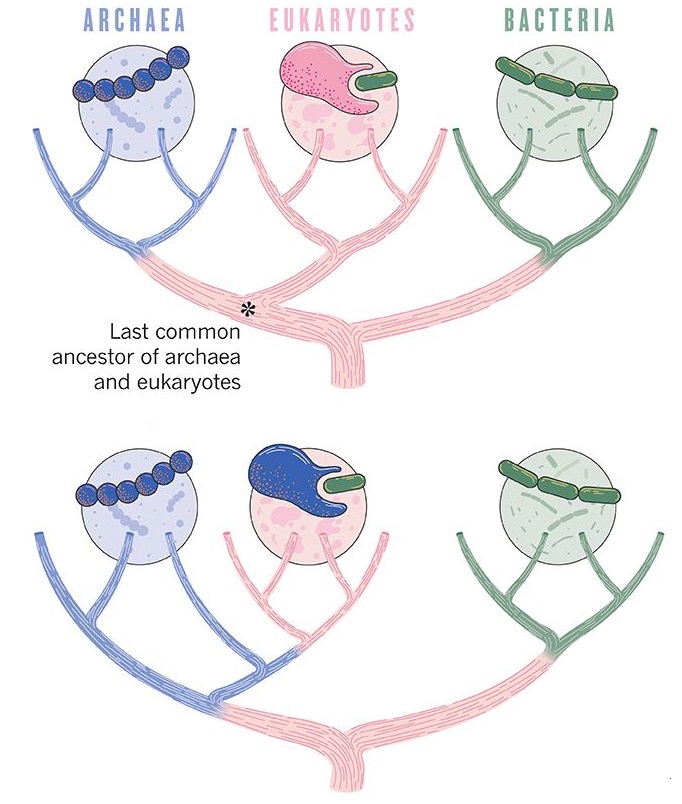 If prokaryotes all come from a common single ancestor, their lines of descent, logically, should branch like a tree. But with only today's genomes, of course it would be challenging to reconstruct the form this tree took billions of generations ago. Horizontal gene transfer (HGT), rampant among prokaryotes, makes it much more challenging. And when eukaryotic sexual reproduction appears, the difficulty is again compounded.
If prokaryotes all come from a common single ancestor, their lines of descent, logically, should branch like a tree. But with only today's genomes, of course it would be challenging to reconstruct the form this tree took billions of generations ago. Horizontal gene transfer (HGT), rampant among prokaryotes, makes it much more challenging. And when eukaryotic sexual reproduction appears, the difficulty is again compounded.
 The trickster microbes that are shaking up the tree of life, doi:10.1038/d41586-019-01496-w, Nature, 14 May 2019. The trickster microbes that are shaking up the tree of life, doi:10.1038/d41586-019-01496-w, Nature, 14 May 2019.
 07 May 2015: Eukaryotic Signature Proteins in Archaea are fueling this round in the dispute. 07 May 2015: Eukaryotic Signature Proteins in Archaea are fueling this round in the dispute.
 The Tree of Life is the main related webpage. The Tree of Life is the main related webpage.
 18 Dec 2018 and 18 Dec 2018 and
 06 Sep 2018 are related recent postings. 06 Sep 2018 are related recent postings.
 Viruses... has lots about HGT. Viruses... has lots about HGT.
 Thanks, Martin Langford. Thanks, Martin Langford.
Would it be simpler and easier to pursue the provenance of individual genes? Where do they come from? We think this question, explored without prejudice, might yield more fruit than the trees.
 New genetic programs... promotes a test. New genetic programs... promotes a test.
 Metazoan Genes Older Than Metazoa? and Metazoan Genes Older Than Metazoa? and
 Genes Older Than Earth? report clues we have noticed. Genes Older Than Earth? report clues we have noticed.
...The subsurface biosphere is the largest biosphere on the planet and holds the majority of microbial life.
...this biosphere ...goes way, way down. ...scientists have still never hit sterile rock.
...microbes use the rock itself as a source of energy.
...under the South Pacific gyre ...were microbes trapped in sediment that was at least 100 million years old.
These quotations come in a brief essay about the deep biosphere, an environment of renewed interest. Biologists already knew that bacteria come in a wide variety, but now we glimpse a whole new world of them. If bacteria are so durable, resourceful and ubiquitous, perhaps they could persist in space and survive on other planets?
 ...The vast world of hidden microbes miles beneath your feet by Graham Lawton, NewScientist, 08 May 2019. ...The vast world of hidden microbes miles beneath your feet by Graham Lawton, NewScientist, 08 May 2019.
 Thanks for sharing the complete article, Martin Langford. Thanks for sharing the complete article, Martin Langford.
 02 Oct 2018 and 02 Oct 2018 and
 10 Dec 2018: related reports. 10 Dec 2018: related reports.
 Bacteria... has more about their survival capabilities. Bacteria... has more about their survival capabilities.
| 11 May 2019 | What'sNEW about HGT  | | |
...the LCA of all Phytophaga beetles most likely acquired a single GH45 gene from a fungal donor.
...the Phytophaga GH45s have adapted to substrate shifts.
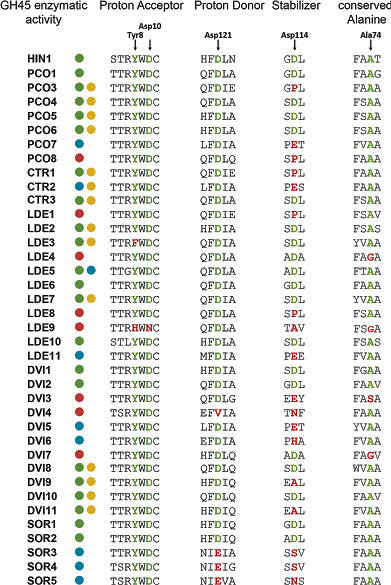 These observations come from a thoroughgoing analysis of certain cellulase genes in leaf-eating beetles.
These observations come from a thoroughgoing analysis of certain cellulase genes in leaf-eating beetles.
We suppose that macroevolutionary advances must be ultimately supplied by the horizontal gene transfer (HGT) of lengthy new programming. The acquired enzyme analysed here, for example, is more than 200 amino acids (600 exonic nucleotides) long. After installation, we think accelerated point mutations allow new genes and their duplicates to become optimized for new situations. Optimization (microevolution by our definition) may be possible with only a few (1 - 10) amino acid substitutions in the right places, as Busch et al. report (see chart, right). In sum, this study affirms the scenario we advocate.
 Functional diversification of horizontally acquired glycoside hydrolase family 45 (GH45) proteins in Phytophaga beetles [PDF] by André Busch, Etienne G. J. Danchin and Yannick Pauchet, BMC Evolutionary Biology, doi:10.1186/s12862-019-1429-9, 10 May 2019. Functional diversification of horizontally acquired glycoside hydrolase family 45 (GH45) proteins in Phytophaga beetles [PDF] by André Busch, Etienne G. J. Danchin and Yannick Pauchet, BMC Evolutionary Biology, doi:10.1186/s12862-019-1429-9, 10 May 2019.
...we combined functional and phylogenetic analyses to unravel the origin, evolution and functional diversification of the GH45 family in Phytophaga beetles.
 Macroevolutionary Progress Redefined... explains how macro- and microevolution are different. Macroevolutionary Progress Redefined... explains how macro- and microevolution are different.
 Viruses... is our main page about HGT. Viruses... is our main page about HGT.
 Robust Software Management... mentions adaptive (accelerated) and directed (targeted) mutation. Robust Software Management... mentions adaptive (accelerated) and directed (targeted) mutation.
 Could Life on Earth Have Come from Another Star System? by Mike Wall, Space.com (+NBCNews), 03 May 2019. Could Life on Earth Have Come from Another Star System? by Mike Wall, Space.com (+NBCNews), 03 May 2019.
 Thanks, Google Alerts. Thanks, Google Alerts.
 01 Nov 2017: A passing object adds evidence for interstellar panspermia. 01 Nov 2017: A passing object adds evidence for interstellar panspermia.
| 01 May 2019 | What'sNEW about HGT  | | |
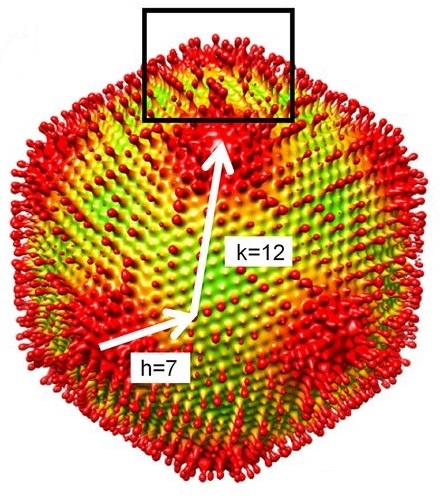 ...there is likely a relationship between the Medusavirus and the origin of eukaryotic life, says Masaharu Takemura, coauthor of a new study. The dsDNA genome appears to contain 461 genes, including ones for all five types of eukaryotic histones and one DNA polymerase. The researchers notice abundant evidence for horizontal gene transfer (HGT) between the virus and its host, an amoeba, and they speculate that such transfer may have helped to launch eukaryotic life. We welcome this unblindered observation.
...there is likely a relationship between the Medusavirus and the origin of eukaryotic life, says Masaharu Takemura, coauthor of a new study. The dsDNA genome appears to contain 461 genes, including ones for all five types of eukaryotic histones and one DNA polymerase. The researchers notice abundant evidence for horizontal gene transfer (HGT) between the virus and its host, an amoeba, and they speculate that such transfer may have helped to launch eukaryotic life. We welcome this unblindered observation.
Also of note to us, 60% of the Medusavirus genes, 279, are unfamiliar ones with unknown functions. So called "ORFan" genes are starting to look numberless, and they are especially abundant among large viruses. If ORFan genes are widely available from viruses, are they an inventory of potential de novo genes, the ones that "seem to have come from nowhere" in the evolution of eukaryotes?
 Medusavirus, a Novel Large DNA Virus Discovered from Hot Spring Water by Genki Yoshikawa et al., doi:10.1128/JVI.02130-18, J Virol, online 03 Apr 2019. Medusavirus, a Novel Large DNA Virus Discovered from Hot Spring Water by Genki Yoshikawa et al., doi:10.1128/JVI.02130-18, J Virol, online 03 Apr 2019.
 New giant virus may help scientists better understand the emergence of complex life, Tokyo University of Science (+Science Daily), 26 Apr 2019. The results of an evolutionary analysis done by the authors suggest that in the evolution tree, the Medusavirus DNA polymerase lies at the origin of the DNA polymerase found in eukaryotes. ...this could mean that our DNA polymerase probably originated from Medusavirus or one of its relatives. New giant virus may help scientists better understand the emergence of complex life, Tokyo University of Science (+Science Daily), 26 Apr 2019. The results of an evolutionary analysis done by the authors suggest that in the evolution tree, the Medusavirus DNA polymerase lies at the origin of the DNA polymerase found in eukaryotes. ...this could mean that our DNA polymerase probably originated from Medusavirus or one of its relatives.
 Viruses...: background and links about viral genes in eukaryotic evolution. Viruses...: background and links about viral genes in eukaryotic evolution.
 13 Jun 2018 and 13 Jun 2018 and
 25 Jan 2013: more about ORFans. 25 Jan 2013: more about ORFans.
 13 May 2011: an archive of cellular genes in viruses? 13 May 2011: an archive of cellular genes in viruses?
 Three New Human Genes has links and more about de novo genes. Three New Human Genes has links and more about de novo genes.
 Thanks, Stan Franklin and Martin Langford. Thanks, Stan Franklin and Martin Langford.
...microbes can impact major geological processes happening on Earth today.
 Forearc carbon sink reduces long-term volatile recycling into the mantle by P.H. Barry et al., Nature, 24 Apr 2019. Forearc carbon sink reduces long-term volatile recycling into the mantle by P.H. Barry et al., Nature, 24 Apr 2019.
 Major deep carbon sink linked to microbes at volcanic island chains, National Science Foundation, 24 Apr 2019. Major deep carbon sink linked to microbes at volcanic island chains, National Science Foundation, 24 Apr 2019.
 ...Microbes could influence Earth's geological processes..., University of Tennessee (+Newswise), 25 Apr 2019. ...Microbes could influence Earth's geological processes..., University of Tennessee (+Newswise), 25 Apr 2019.
 Gaia has comments about the burial of carbon on the ocean floor. Gaia has comments about the burial of carbon on the ocean floor.
New data show the universe expanding 9% faster than predicted by the big bang theory.
 Mystery of the Universe's Expansion Rate Widens with New Hubble Data, Space Telescope Science Institute (+Newswise), 25 Apr 2019. Mystery of the Universe's Expansion Rate Widens with New Hubble Data, Space Telescope Science Institute (+Newswise), 25 Apr 2019.
 The universe seems to be expanding faster than all expectations by Michael Greshko, National Geographic, 25 Apr 2019. The universe seems to be expanding faster than all expectations by Michael Greshko, National Geographic, 25 Apr 2019.
 The universe may be a billion years younger than we thought... by Corey S. Powell, NBC News, 18 May 2019. The universe may be a billion years younger than we thought... by Corey S. Powell, NBC News, 18 May 2019.
 Thanks, Rob Cooper and Stan Franklin. Thanks, Rob Cooper and Stan Franklin.
The discrepancy suggests that there's something in the cosmological model that we're not understanding right.
 Large Magellanic Cloud Cepheid Standards Provide a 1% Foundation for the Determination of the Hubble Constant and Stronger Evidence for Physics Beyond ΛCDM by Adam G. Riess et al., doi:10.3847/1538-4357/ab1422, arXiv:1903.07603v2, 28 Mar 2019. Large Magellanic Cloud Cepheid Standards Provide a 1% Foundation for the Determination of the Hubble Constant and Stronger Evidence for Physics Beyond ΛCDM by Adam G. Riess et al., doi:10.3847/1538-4357/ab1422, arXiv:1903.07603v2, 28 Mar 2019.
 The End and the Big Bang is related. The End and the Big Bang is related.
The concept of gradual evolution driven by natural selection acting on differences between individuals of a species must be supplemented with saltational change resulting from horizontal gene transfer and symbiosis....
 Saltational symbiosis by Jan Sapp, Theory Biosci, Sep 2010. Saltational symbiosis by Jan Sapp, Theory Biosci, Sep 2010.
...Is it not time, for the advancement of science, to drop the adjective "Darwinian" from evolution?
Every spoonful of seawater is filled with millions of viruses.
 Hundreds of thousands of marine viruses discovered in world's oceans by Erin I. Garcia de Jesus, Nature, 25 Apr 2019. Hundreds of thousands of marine viruses discovered in world's oceans by Erin I. Garcia de Jesus, Nature, 25 Apr 2019.
 Marine DNA Viral Macro- and Microdiversity from Pole to Pole by Ann C. Gregory, et al., doi:10.1016/j.cell.2019.03.040,
Cell, 16 May 2019. Marine DNA Viral Macro- and Microdiversity from Pole to Pole by Ann C. Gregory, et al., doi:10.1016/j.cell.2019.03.040,
Cell, 16 May 2019.
 Thanks, Martin Langford. Thanks, Martin Langford.
the "grammar" of proteins can be investigated using tools borrowed from linguistics — Lijia Yu et al.
A new study begins with the premise that protein domains are the basic units of meaning in genomes. The researchers, from the University of Alabama in Birmingham and the National Institutes of Health, compare them to words in a written language. They demonstrate that protein domains and words occur with mathematically similar patterns and frequencies, apparently following similar grammars. We welcome this insight, because it suggests a tool for the toolkit that we think life's evolution needs.
Consider an analogy we have offered before: word-processing programs can identify spelling, syntactical and gramatical errors, and suggest or make corrections. Even if some passages are out of order, the error-recognition logic could be deployed to properly order them. Now consider genomes. Suppose some protein domains, usually between a hundred and a thousand nucleotides long, are out of place. If genomes have an analogous capability, they could properly order the domains. The new study strengthens our view that genomes could have such capabilities.
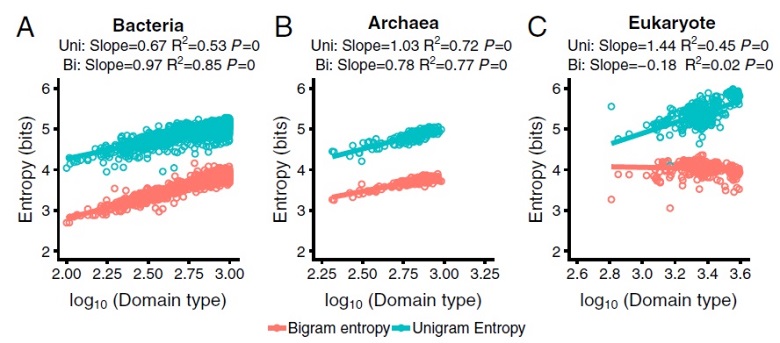
All life forms possess many multidomain proteins, but both the number of unique domains and the fraction of multidomain proteins increase with the organismal complexity (defined as the number of unique cell types in an organism): Eukaryotes have more multidomain proteins than prokaryotes, and animals have more multidomain proteins than unicellular eukaryotes. This trend of increased multidomain protein formation with increasing organismal complexity is known as domain accretion and apparently plays a major role in evolution, particularly in major evolutionary transitions such as the origin of multicellularity.
 Grammar of protein domain architectures by Lijia Yu et al., doi:10.1073/pnas.1814684116, PNAS, 26 Feb 2019. Grammar of protein domain architectures by Lijia Yu et al., doi:10.1073/pnas.1814684116, PNAS, 26 Feb 2019.
|
 Introns... is related. Introns... is related.
 Robust Software Management... is a new related (incomplete) page. Robust Software Management... is a new related (incomplete) page.
 14 Jun 2016: more about software management. 14 Jun 2016: more about software management.
 The Second Law... explains why entropy is a confusing term. The Second Law... explains why entropy is a confusing term.
Potentially, interstellar meteors could deliver life from another planetary system and mediate panspermia.
 Discovery of a Meteor of Interstellar Origin by Amir Siraj and Abraham Loeb, arXiv:1904.07224v1, 15 Apr 2019. Discovery of a Meteor of Interstellar Origin by Amir Siraj and Abraham Loeb, arXiv:1904.07224v1, 15 Apr 2019.
 Harvard Scientists Say Earth Was Struck by an Interstellar Object 5 Years Ago by Peter Dockrill, Science Alert; & Harvard Scientists Say Earth Was Struck by an Interstellar Object 5 Years Ago by Peter Dockrill, Science Alert; &
 Interstellar object hit Earth and it could explain how life began by Sean Martin, Express.co.uk, 17 Apr 2019. Interstellar object hit Earth and it could explain how life began by Sean Martin, Express.co.uk, 17 Apr 2019.
 08 Feb 2018 & 08 Feb 2018 &  15 Oct 2018: more from Loeb et al.. 15 Oct 2018: more from Loeb et al..
 Thanks, Google Alerts and Justin Willingham. Thanks, Google Alerts and Justin Willingham.
The brown signature of melts and olivine could be caused by magnetotactic bacteria....
Another Mars meteorite may carry traces past life, namely the partially-melted remains of iron-oxidizing bacteria. The structures require interpretation, but the observed carbon isotope anomaly usually comes from life, on Earth anyway.
 Mineralized biosignatures in ALH-77005 Shergottite - Clues to Martian Life? by Ildikó Gyollai et al., doi:10.1515/astro-2019-0002, De Gruyter, Jan 2019; and
commentary, MarsDaily, 05 Apr 2019. Mineralized biosignatures in ALH-77005 Shergottite - Clues to Martian Life? by Ildikó Gyollai et al., doi:10.1515/astro-2019-0002, De Gruyter, Jan 2019; and
commentary, MarsDaily, 05 Apr 2019.
 Claimed Signs of Life in a Martian Meteorite by Dirk Schulze-Makuch, airspacemag.com, 06 May 2019. Claimed Signs of Life in a Martian Meteorite by Dirk Schulze-Makuch, airspacemag.com, 06 May 2019.
 Thanks, Ronnie McGhee and Rob Cooper. Thanks, Ronnie McGhee and Rob Cooper.
 Life on Mars! has lots about ALH84001. Life on Mars! has lots about ALH84001.
 No detection of methane on Mars from early ExoMars Trace Gas Orbiter observations by Oleg Korablev et al., Nature, 10 Apr 2019. No detection of methane on Mars from early ExoMars Trace Gas Orbiter observations by Oleg Korablev et al., Nature, 10 Apr 2019.
 ...Why Hasn't a New Spacecraft Found It? by Kenneth Chang, The New York Times, 10 Apr 2019. ...Why Hasn't a New Spacecraft Found It? by Kenneth Chang, The New York Times, 10 Apr 2019.
 25 Jun 2019! 25 Jun 2019!
 Microbes in the human body swap genes, even across tissue boundaries, UIUC (+ Physorg.com), 11 Apr 2019. Microbes in the human body swap genes, even across tissue boundaries, UIUC (+ Physorg.com), 11 Apr 2019.
 Horizontal gene transfer in human-associated microorganisms inferred by phylogenetic reconstruction and reconciliation by Hyeonsoo Jeong et al., doi:10.1371/journal.pgen.1007995, Nature Scientific Reports, 11 Apr 2019. Horizontal gene transfer in human-associated microorganisms inferred by phylogenetic reconstruction and reconciliation by Hyeonsoo Jeong et al., doi:10.1371/journal.pgen.1007995, Nature Scientific Reports, 11 Apr 2019.
The modern Synthesis ... is a correct theory but only for a narrow range of evolutionary processes in certain groups of oranisms — Eugene Koonin, 2017, quoted in
Darwin Overthrown: Hello Mechanobiology, by Suzan Mazur, Caswell Books, 2019.
 09 Apr 2019: our unfiltered comments to Mazur about the book. 09 Apr 2019: our unfiltered comments to Mazur about the book.
| 08 Apr 2019 | What'sNEW about HGT  | | |
Genetic mutations can be induced by environmental stress, and they often occur at just the right place. The mutations, to be installed, require complex DNA repair mechanisms depending on many genes. In addition to nucleotide substitutions, insertions or deletions, Environmental stress up-regulates the activity of mobile DNA elements in many organisms, and this inducible genome instability is likely to be an important driver of evolution. These observations come in an open-access article by molecular geneticists Devon M. Fitzgerald and Susan M. Rosenberg of Baylor College of Medicine.
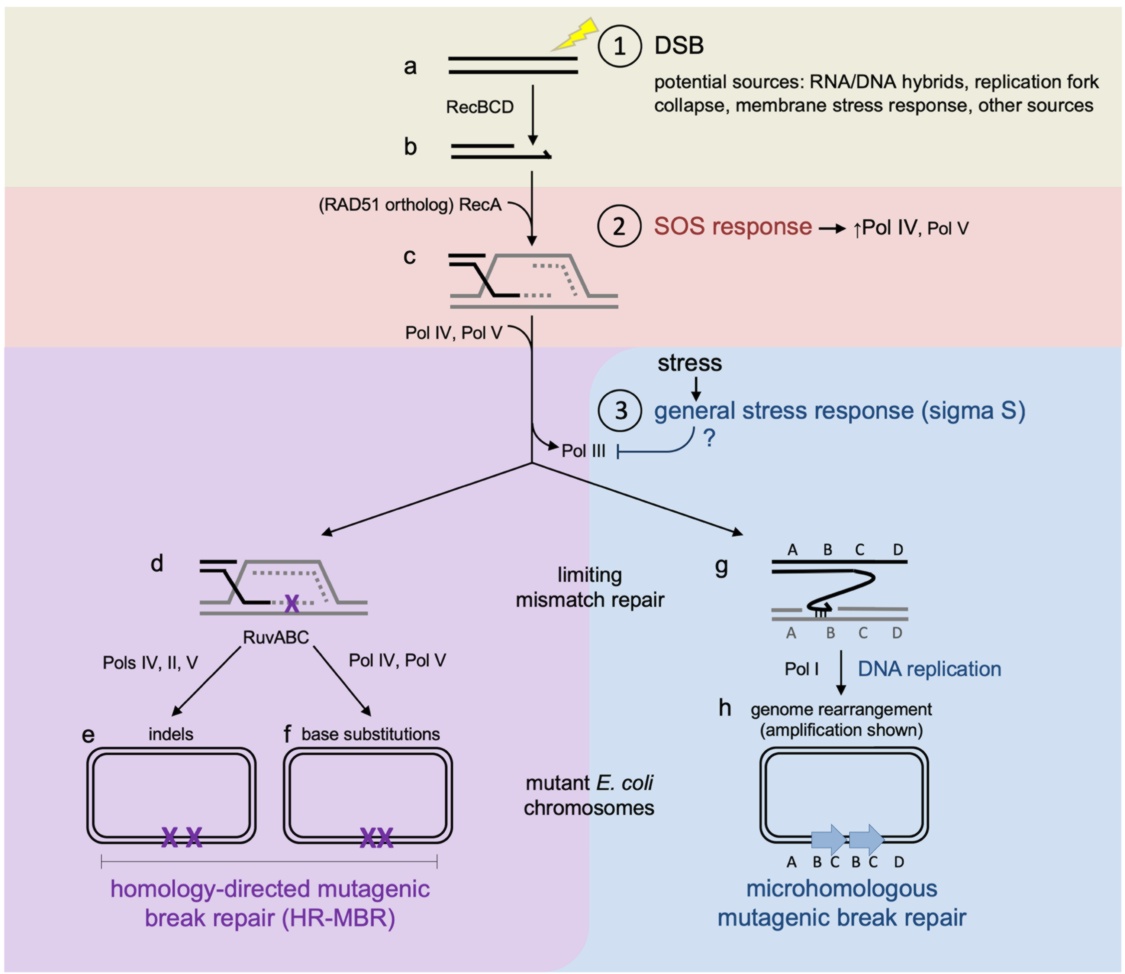
The authors focus on bacteria and yeast cells, but stress response-up-regulated mutation mechanisms have been discovered in plants, flies, and human cells. Edited by W. Ford Doolittle, the article concludes, regulated mutagenesis mechanisms greatly increase the probability that the useful mutations will occur at the right time, thus increasing an organism's ability to evolve and, possibly, in the right places. Assumptions about the constant, gradual, clock-like, and environmentally blind nature of mutation are ready for retirement..
The findings are consistent with our belief that genomes must have robust software management systems to keep them functional and adaptable. (And the necessary high-fidelity DNA repair might be difficult to evolve, the report mentions.) Robust software management would also manage horizontal gene transfer (HGT), which stress may also induce. We mention HGT in order to clarify its role in cosmic ancestry —
We agree, rearrangements within an existing genome can have profound effects, both positive and negative. For a positive one, suppose that a silent beneficial gene needs only to be turned on, or a key exon needs relocation. If this change is effected and inherited, a beneficial evolutionary step is enabled. But if the gene or exon is not available, stress alone cannot induce that evolutionary step. In other words, there is a near limit to the range of evolution within a quarantined genome. Suppose an evolutionary step requires a unique strand of, say, 200 or more properly sequenced nucleotides. If the strand is not already present, the evolutionary step will not occur. Of course, HGT could supply it. But without HGT, macroevolutionary progress would soon halt, we believe.
We scan the literature regularly for relevant evidence, and HGT is obseved frequently enough, in all domains. Also, we have proposed research programs in biology and in computer models to test the importance of HGT, with no serious takers. Meanwhile, we welcome these straightforward observations from Fitzgerald and Rosenberg.
These mechanisms reveal a picture of highly regulated mutagenesis, up-regulated temporally by stress responses and activated when cells/organisms are maladapted to their environments—when stressed—potentially accelerating adaptation. Mutation is also nonrandom in genomic space, with multiple simultaneous mutations falling in local clusters, which may allow concerted evolution—the multiple changes needed to adapt protein functions and protein machines encoded by linked genes.
 What is mutation? A chapter in the series: How microbes "jeopardize" the modern synthesis by Devon M. Fitzgerald and Susan M. Rosenberg, doi:10.1371/journal.pgen.1007995, PLoS Genet., 01 Apr 2019. What is mutation? A chapter in the series: How microbes "jeopardize" the modern synthesis by Devon M. Fitzgerald and Susan M. Rosenberg, doi:10.1371/journal.pgen.1007995, PLoS Genet., 01 Apr 2019.
|
 New genetic programs... describes a rudimentary test. New genetic programs... describes a rudimentary test.
 The Evolution Prize... was an advertised test that flopped. The Evolution Prize... was an advertised test that flopped.
 Is Evolutionary Progress ...Possible? has discussion and updates about a long-running quarantined experiment. Is Evolutionary Progress ...Possible? has discussion and updates about a long-running quarantined experiment.
 Macroevolutionary Progress Redefined: Can It Happen Without Gene Transfer? has related discussion. Macroevolutionary Progress Redefined: Can It Happen Without Gene Transfer? has related discussion.
 Viruses... is our main webpage about HGT. Viruses... is our main webpage about HGT.
 2018 2018
 2017 2017
 2016 2016
 2015 2015
 2003: various examples of stress-induced or non-random HGT. 2003: various examples of stress-induced or non-random HGT.
 The Second Law of Thermodynamics makes our argument logically. The Second Law of Thermodynamics makes our argument logically.
 Robust Software Management... is incomplete. Robust Software Management... is incomplete.
 The Beginning and The Beginning and
 Evolution vs Creationism mention questions asking, "...in the first place?" Evolution vs Creationism mention questions asking, "...in the first place?"
 Independent confirmation of a methane spike on Mars and a source region east of Gale Crater, by Marco Giuranna et al., Nature Geoscience, Apr 2019. Independent confirmation of a methane spike on Mars and a source region east of Gale Crater, by Marco Giuranna et al., Nature Geoscience, Apr 2019.
 Thanks, Sky & Telescope. Thanks, Sky & Telescope.
 Life on Mars! has more about methane there. Life on Mars! has more about methane there.
On Earth biological sources ...produce 95% of the methane in our atmosphere.
 12 Apr 2019 and 12 Apr 2019 and
 25 Jun 2019: new observations. 25 Jun 2019: new observations.
D. geothermalis remained viable in the desiccated state, being able to survive space and Mars-like conditions and tolerating high extraterrestrial UV radiation for more than 2 years.
 Tolerances of Deinococcus geothermalis Biofilms and Planktonic Cells Exposed to Space and Simulated Martian Conditions in Low Earth Orbit..., by Corinna Panitz et al., Astrobiology, online 29 Mar 2019. Tolerances of Deinococcus geothermalis Biofilms and Planktonic Cells Exposed to Space and Simulated Martian Conditions in Low Earth Orbit..., by Corinna Panitz et al., Astrobiology, online 29 Mar 2019.
 Bacteria... has lots more. Bacteria... has lots more.
![]()
|
 ...exchange of materials between solar systems during close stellar encounters could be an important mechanism for spreading life throughout the galaxy. This conclusion comes in a volumetric analysis of the sun's meanderings among neighboring stars, by astrobiologist Robert Zubrin. Comets and cometary dust in the Oort clouds, ours and theirs, can be swapped with surprising frequency. These encounters could explain large impacts and major evolutionary transitions on Earth, Zubrin also notes.
...exchange of materials between solar systems during close stellar encounters could be an important mechanism for spreading life throughout the galaxy. This conclusion comes in a volumetric analysis of the sun's meanderings among neighboring stars, by astrobiologist Robert Zubrin. Comets and cometary dust in the Oort clouds, ours and theirs, can be swapped with surprising frequency. These encounters could explain large impacts and major evolutionary transitions on Earth, Zubrin also notes.
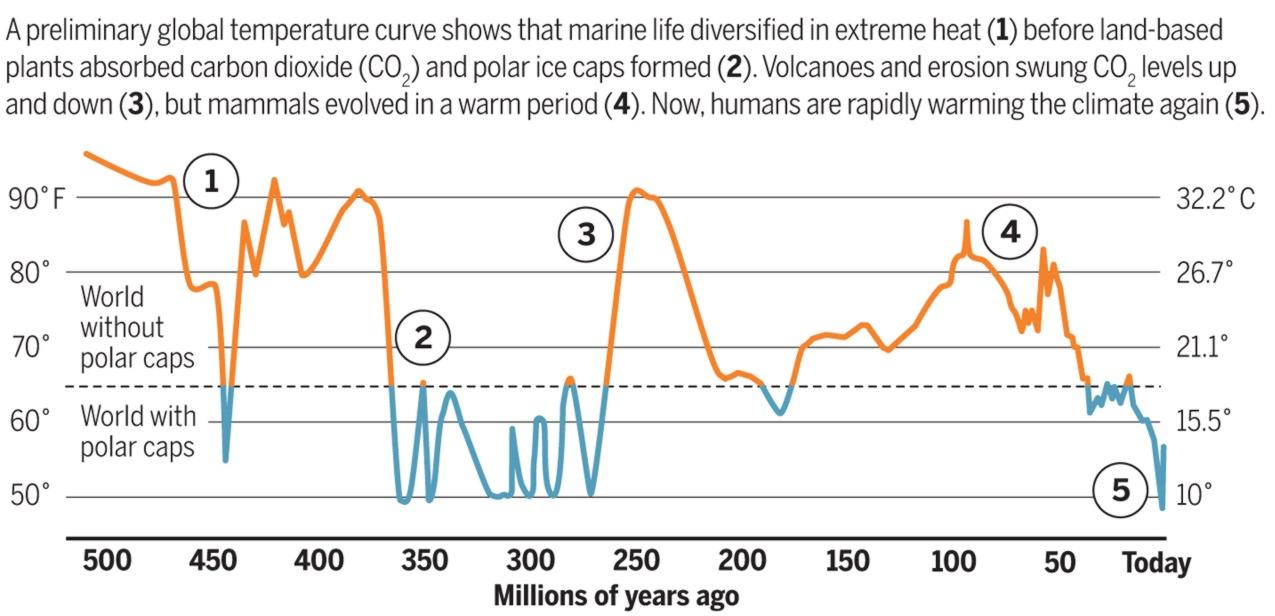
 These observations come from a thoroughgoing analysis of certain cellulase genes in leaf-eating beetles.
These observations come from a thoroughgoing analysis of certain cellulase genes in leaf-eating beetles.
 ...there is likely a relationship between the Medusavirus and the origin of eukaryotic life, says Masaharu Takemura, coauthor of a new study. The dsDNA genome appears to contain 461 genes, including ones for all five types of eukaryotic histones and one DNA polymerase. The researchers notice abundant evidence for horizontal gene transfer (HGT) between the virus and its host, an amoeba, and they speculate that such transfer may have helped to launch eukaryotic life. We welcome this unblindered observation.
...there is likely a relationship between the Medusavirus and the origin of eukaryotic life, says Masaharu Takemura, coauthor of a new study. The dsDNA genome appears to contain 461 genes, including ones for all five types of eukaryotic histones and one DNA polymerase. The researchers notice abundant evidence for horizontal gene transfer (HGT) between the virus and its host, an amoeba, and they speculate that such transfer may have helped to launch eukaryotic life. We welcome this unblindered observation.


 If prokaryotes all come from a common single ancestor, their lines of descent, logically, should branch like a tree. But with only today's genomes, of course it would be challenging to reconstruct the form this tree took billions of generations ago. Horizontal gene transfer (HGT), rampant among prokaryotes, makes it much more challenging. And when eukaryotic sexual reproduction appears, the difficulty is again compounded.
If prokaryotes all come from a common single ancestor, their lines of descent, logically, should branch like a tree. But with only today's genomes, of course it would be challenging to reconstruct the form this tree took billions of generations ago. Horizontal gene transfer (HGT), rampant among prokaryotes, makes it much more challenging. And when eukaryotic sexual reproduction appears, the difficulty is again compounded.